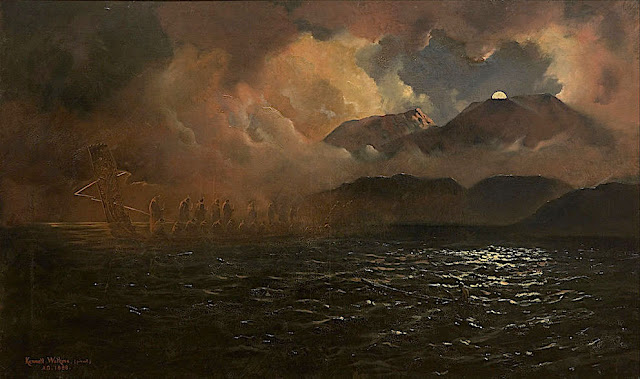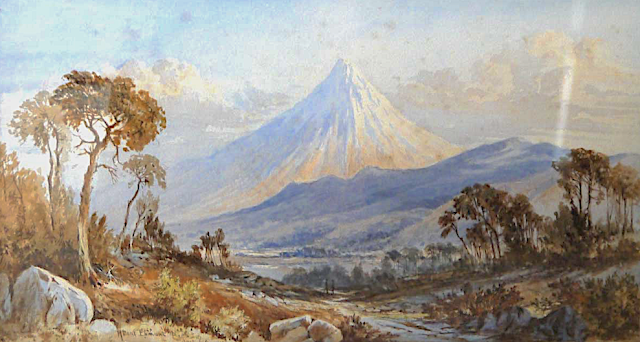CHARLES BLOMFIELD (1848-1926)
Mount Tarawera (1, 111m - 3,645ft)
New Zealand (North Island)
The full extraordinsary story of this unbelievable volcano in paintings is HERE
The mountain
Mount Tarawera
(1, 111m - 3,645ft) is
the volcano responsible for one of New Zealand's largest historic
eruptions. Located 24 kilometres southeast of Rotorua in the North
Island, it consists of a series of rhyolitic lava domes that were
fissured down the middle by an explosive basaltic eruption in 1886,
which killed an estimated 120 people. These fissures run for about 17
kilometres northeast-southwest.
The volcano's component domes include Ruawahia Dome, Tarawera Dome and
Wahanga Dome. It is surrounded by several lakes, most of which were
created or drastically altered by the 1886 eruption. These lakes include
Lakes Tarawera, Rotomahana, Rerewhakaaitu, Okataina, Okareka, Tikitapu
(Blue Lake) and Rotokakahi (Green Lake). The Tarawera River runs
northeastwards across the northern flank of the mountain from Lake
Tarawera.
Main eruptions
- 1315 : Mount Tarawera erupted for the fist time on modern
history. The ash thrown from this event may have affected temperatures
around the globe and precipitated the Great Famine of 1315–17 in Europe.
- 1886 : Shortly after midnight on the morning of 10 June 1886, a
series of more than 30 increasingly strong earthquakes were felt in the
Rotorua area and an unusual sheet lightning display was observed from
the direction of Tarawera. At around 2:00 am a larger earthquake was
felt and followed by the sound of an explosion. By 2:30 am Mount
Tarawera's three peaks had erupted, blasting three distinct columns of
smoke and ash thousands of metres into the sky (
see painting above).
At around 3.30 am, the largest phase of the eruption commenced; vents
at Rotomahana produced a pyroclastic surge that destroyed several
villages within a 6 kilometre radius, and the Pink and White Terraces
appeared to be obliterated.
The eruption was heard clearly as far away as Blenheim and the effects
of the ash in the air were observed as far south as Christchurch, over
800 km away. In Auckland the sound of the eruption and the flashing sky
was thought by some to be an attack by Russian warships.
Although the official contemporary death toll was 153, exhaustive
research by physicist Ron Keam only identified 108 people killed by the
eruption. Much of the discrepancy was due to misspelled names and other
duplications. Allowing for some unnamed and unknown victims, he
estimated that the true death toll was 120 at most. Some people claim
that many more people died.
The eruption also buried many Māori villages, including Te Wairoa which has now become a tourist attraction (
Buried Village of Te Wairoa) and the world-famous
Pink and White Terraces
were lost. A small portion of the Pink Terraces was rediscovered under
Lake Rotomahana 125 years later. Approximately 2 cubic kilometres of
tephra was erupted, more than
Mount St. Helens ejected
in 1980. Many of the lakes surrounding the mountain had their shapes
and areas dramatically altered, especially the eventual enlargement of
Lake Rotomahana, the largest crater involved in the eruption, as it
re-filled with water.
Legend
One legend surrounding the 1886 eruption is that of the phantom canoe.
Eleven days before the eruption, a boat full of tourists returning from
the
Terraces saw what appeared to be a war canoe approach their
boat, only to disappear in the mist half a mile from them. One of the
witnesses was a clergyman, a local Maori man from the Te Arawa iwi.
Nobody around the lake owned such a war canoe, and nothing like it had
been seen on the lake for many years. It is possible that the rise and
fall of the lake level caused by pre eruption fissures had freed a
burial waka (canoe) from its resting place. Traditionally dead chiefs
were tied in an upright position. A number of letters have been
published from the tourists who experienced the event.
Though skeptics maintained that it was a freak reflection seen on the
mist, tribal elders at Te Wairoa claimed that it was a waka wairua
(spirit canoe) and was a portent of doom. It has been suggested that the
waka was actually a freak wave on the water, caused by seismic activity
below the lake, but locals believe that a future eruption will be
signaled by the reappearance of the canoe.
The painter
Charles Blomfield was a New Zealand decorator, artist and music teacher born in London, England.
A widow, Blomfield's mother brought her family to New Zealand in the
1860's intending to settle in Northland as part of a settlement called
Albertland. On arrival in Auckland they decided not to proceed on
Northland to become farmers but to pursue urban trades in Auckland. The
family remained in Auckland after that and many of the descendants of
the various children still reside in the Auckland area.
Charles Blomfield lived in Freeman's Bay - 40 Wood Street, in a house
built by his brother and allegedly made out of the timber from one large
Kauri tree. As well as an exhibiting easel painter Blomfield worked as a
sign-writer and interior decorator; for this trade he maintained
studios in shops at various times. These were usually on Karangahape
Road, one of these was shared with his daughter who made a living
painting floral pieces which she also exhibited at the Auckland Society
of Arts.
Blomfield travelled throughout the centre of the North Island on several
occasions in the 1870s and 80s creating many landscape paintings of the
New Zealand countryside, often for sale to visitors to New Zealand. He
was fortunate to view the famed Pink and White Terraces several
times and paint them before they were destroyed by the eruption of
Tarawera in 1886. His meticulous sketches and finished paintings are
some of the main records of them (see above). For the remainder
of his life he was probably able to rely on new versions of his classic
views of them to supplement his income.
His paintings are widely regarded as the epitome of 19th century New
Zealand landscape art, although his work, like many of his
contemporaries, fell out of fashion during the 20th century, only to be
re-evaluated in the 1970s. He was unable to come to terms with
developments in art and remained staunchly conservative and hostile to
'modern art'. In his later years he found himself increasingly sidelined
by the artistic circles in Auckland which he had previously shone in
and was probably embittered by this.
Blomfield died at his residence in Wood Street in 1926. He was survived
by several children. One of his brothers, William, was a noted newspaper
cartoonist.
Source :
_____________________________________
2022 - Wandering Vertexes...
Un blog de Francis Rousseau
%20-%20%20Mitre%20Peak:%20Rahotu%20%20Milford%20Sounds-%20Watercolour%20for%20Arts%20Series%20postcard%20board-%20%20NEw%20Zealand%20Posycard%20Society%20.png)

-%20%22Mt%20Sefton%22%20%20watercolor,%20International%20Art%20Centre%20Auclnad%20.png)
-%20Milford%20Sound%20with%20Mount%20Pembroke%20Peak%20and%20Mitre%20Peak:rahotu%20,%201901%20watercolor%20on%20Bristol%20board-%20South%20Coast%20Antiques%20&%20Gallery.jpg)
-Mount%20Amstead,%20Rees%20River,%20%20Matukituki%20River,%20Watercolour-%20Christchurh%20Art%20GAllery-%20Te%20Puna%20o%20Waiwhetu.%20jpg.jpg)

%20New%20Plymouth%20and%20Mt%20Taranaki:%20Egmont%20in%20background-%20ALexander%20Turnbull%20LIbrary.jpeg2.jpg)












